About this product
Model: zwo_asi294mm-pro
Part Number: ZWO ASI294MM-P
New Mono Version of the ASI294MC Camera!
A hugely popular small-format mono camera for astrophotography.
The ZWO ASI 294MM Pro is fitted with a back-illuminated, 4/3” format, 14-bit ADC sensor with 4.63um pixels, an impressive 66ke- full well capacity and 4144x2822 resolution.
It has a very high QE value with a peak of around 90%. It also features an ultra-low readout noise of 1.2e.
The default Bin2 mode combines pixels in a 2x2 group for a 4.6um pixel size, with 14bit ADC, 11.7 megapixels, 4144x28xx resolution and 66k full well capacity, making the camera a versatile camera for different setups and imaging targets.
It can also be used in 'Unlocked Bin1 Mode', which enables you to use the camera at the native pixel size of 2.3um, with a 12bit ADC at 47 megapixels, 8288x5644 resolution and 14k full well capacity.
All ZWO cameras include a 2-year warranty.
FEATURES
- Sony IMX492 CMOS Sensor
- Extremely low read noise - 1.26e @30db gain
- 14Bit ADC - provides real 14bit dynamic range
- Electronic shutter - no issues with vibrations sometimes found in mechanical shutters
- USB3.0 Port (back compatible with USB2.0)
- AR-coated protective window - all light can pass
- Compatible with Windows / Mac OS / Linux
14-bit ADC and 13stops dynamic range
The Mono ASI294MM Pro has very similar parameters as the colour version. Both have 14-bit ADC and a high dynamic range of 13 stops (even higher than the ASI1600MM Pro camera).
Camera Field of View Simulator
Backlit Sensor
The back-illuminated CMOS sensor improves sensitivity and noise reduction – key factors to enhancing image quality - while radically realigning their fundamental pixel structure from front-illumination to back-illumination. It retains the advantages of CMOS image sensors, such as low power consumption and high-speed operation.
With a conventional front-illumination structure, the metal wiring and transistors on the silicon substrate surface that form the sensor’s light-sensitive area (photo-diode) impede photon gathering carried out by the on-chip lens. A back-illuminated structure minimises the degradation of sensitivity to optical angle response while also increasing the amount of light that enters each pixel due to the lack of obstacles, such as metal wiring and transistors that have been moved to the reverse of the silicon substrate.

Unlocked Bin1 Mode
A special feature of the ASI294MM-Pro is the switchable pixel size. The default setting is Bin2 which gives 4.6um pixels, but you can switch to Bin1 mode in software to use the native pixel size of 2.3um. This is called 'unlocked Bin1 Mode.
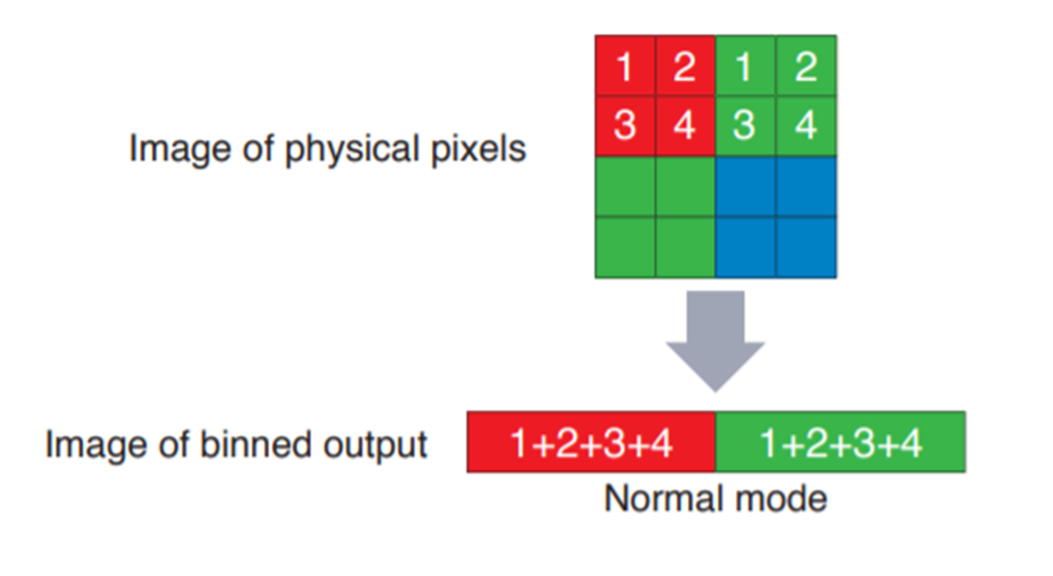
Unlocked Bin1: 12bit ADC, 2.3um pixel size, 47 megapixels, 8288*5644 resolution, 14k full well capacity.
Bin2 (The default mode): 14bit ADC, 4.6um pixel size, 11.7 megapixels, 4144x2822 resolution, 66k full well capacity.
Compare the performance charts below to learn more about the differences between unlocked Bin1 and Bin2 modes.
Camera Performance
The ZWO ASI 294MM Pro has a large well depth capacity, low read-out noise and high dynamic range.
The full well capacity of 66387e of ASI 294MM Pro is among the best ASI DSO cameras. It ensures a very high dynamic range of up to 13 stops, which significantly reduces overexposure probability and helps achieve richer colour gradation.
When the gain value is 120, the magical HCG high gain mode is turned on, the readout noise is significantly reduced (as low as 1.2e), and the dynamic range basically unchanged.
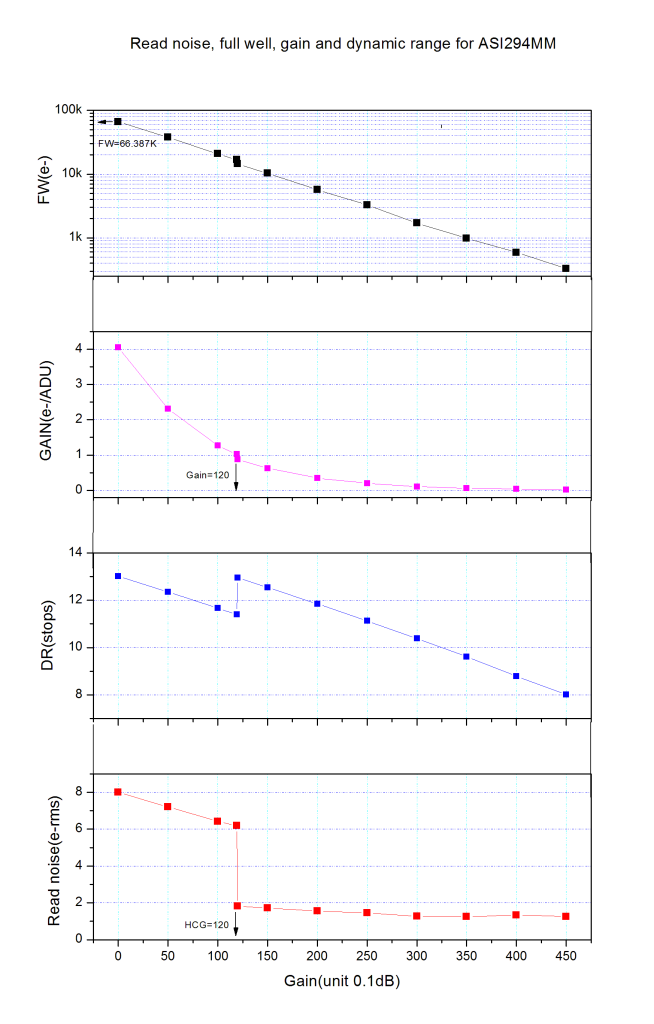
Performance in Bin1 mode is shown below:
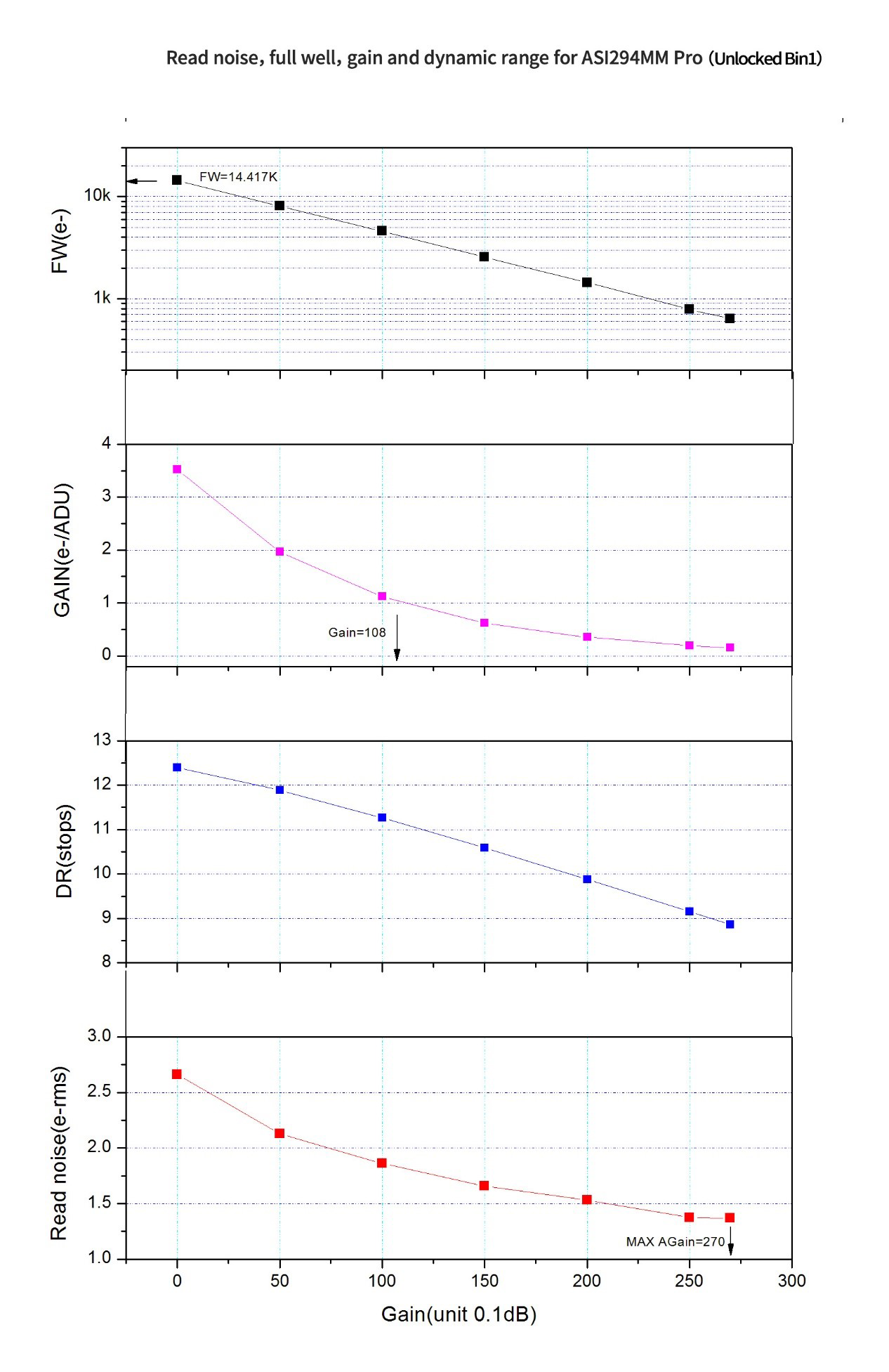
If the sampling accuracy achieved with the 2.3um pixel size falls into a reasonable range, then the unlocked Bin1 mode will enhance object details. However, you will lose some dynamic range and the bit depth of ADC. Also, the image files at Bin1 will probably be four times bigger than Bin2.
So, ultimately, unlocked Bin1 mode is a double-edged feature. You may or may not choose to use it.
Reliable Mechanics
There are four screws on the camera that seal the sensor chamber. This design has been extensively tested and is very stable. Even when used in higher humidity environments, ASI294MM Pro will work fine without dew problems.
QE Value
As ZWO’s latest BSI (backside illuminated type) mono camera, ASI294MM Pro has very high QE performance. Higher than its colour version and even the ASI 1600MM Pro. It is estimated that the QE peak value is around 90%.
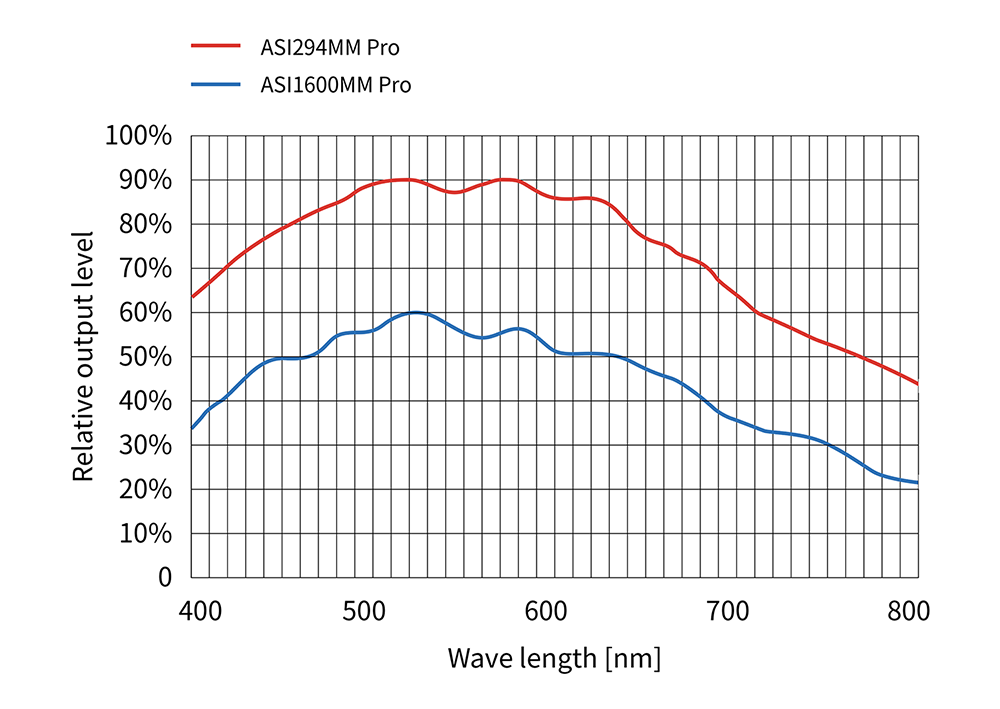
ASI294MM Pro vs ASI1600MM Pro
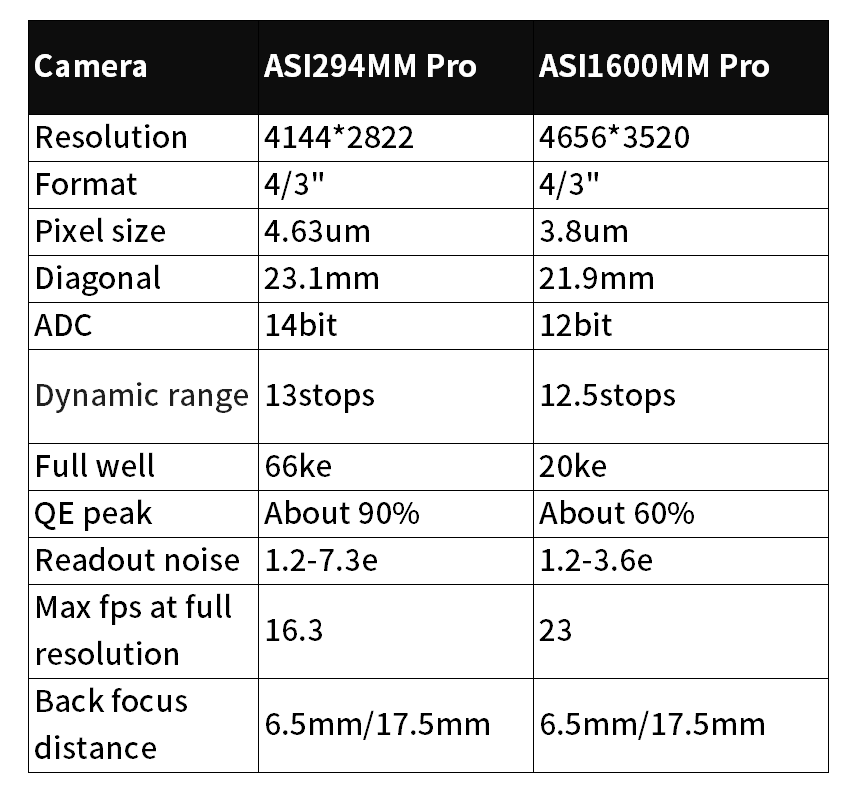
Two-Stage TEC Cooling: Ultra-Low Dark Current
ASI294MM Pro uses two-stage TEC cooling to lower the CMOS sensor temperature to 35c~40c below ambient, significantly reducing dark current generation and sensor noise even with extended exposure times.
The unique dark current suppression technology can even further reduce dark current noise. When it’s cooled to -20℃, the current noise can be as low as 0.0022e/s/pix, which is negligible!
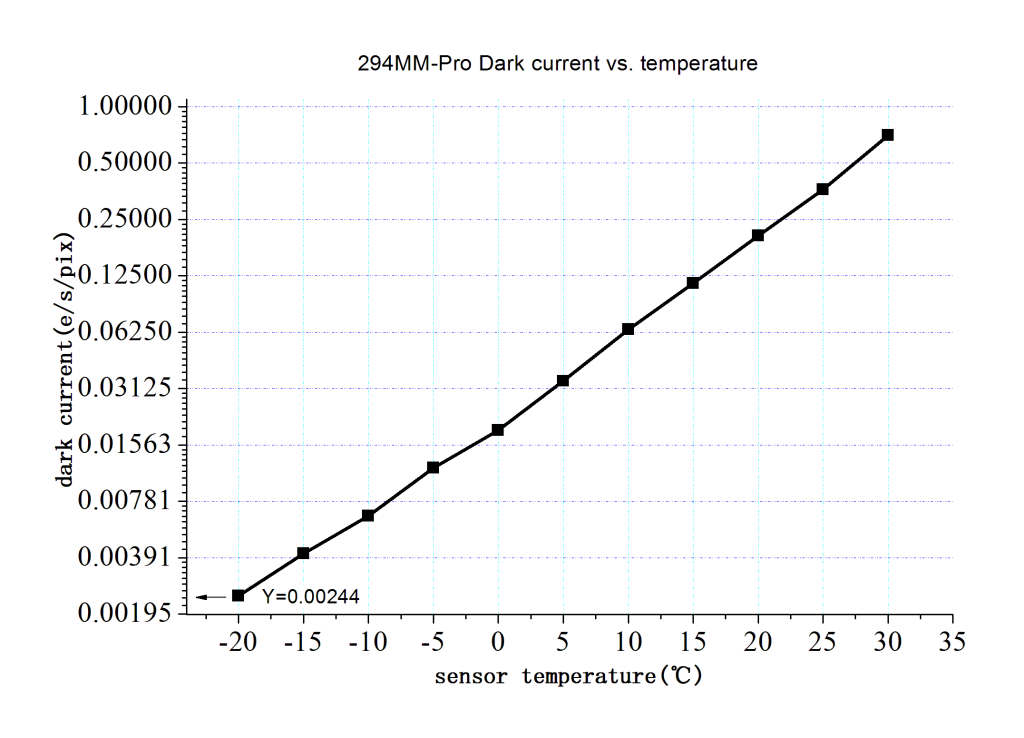
Please note the camera must be connected to an external 12v power supply to implement the cooling function. We recommend you use a 12V@3A DC adapter (5.5x2.1mm, centre pole positive) or lithium battery with 11-15V to power the camera.
USB3.0 & 256M DDR3 Memory
The ASI294MM Pro has a USB 3.0 transmission interface and an integral 256MB DDR3 cache to ensure stable and secure data transmission.
Under long exposure, it effectively avoids frame dropping and reduces the glow effect caused by slow reading speed.
For information about amp glow, please refer to this tutorial: “What is Amp-glow and how do I manage it?“
https://astronomy-imaging-camera.com/faq
Mechanical Diagram
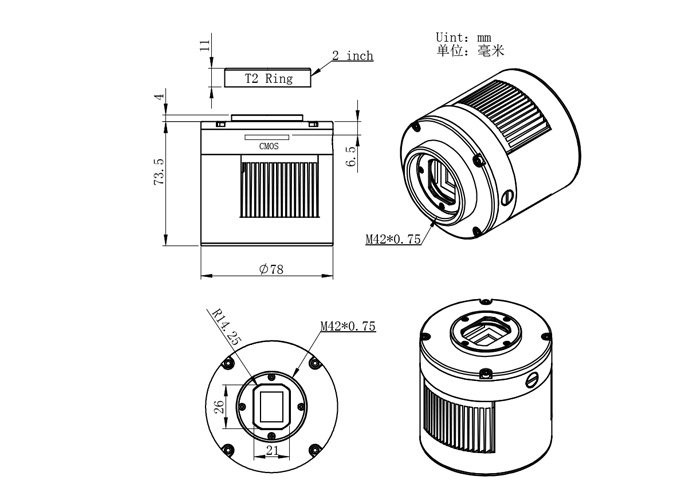
What's in the box
- ASI294MM-Pro Camera
- Soft Padded Case
- T2-1.25" Nosepiece Adapter
- 1.25" Cap
- 2-metre USB 3.0 Cable
- USB 2.0 Short Cable x2
- T2-1.25" Adapter
- T2 Extender 21mm
- T2-M48 16.5mm Extender
- M42 to M48 Adapter
- Spacers x2
- Quick Start Guide
- Driver CD
Specifications
| Sensor | 4/3″ SONY IMX492 CMOS |
| Diagonal | 23.2mm |
| Resolution | 11.7Mega Pixels 4144X2822 |
| Pixel Size | 4.63µm |
| Shutter | Rolling shutter |
| Exposure Range | 32µs-2000s |
| ROI | Supported |
| Read Noise | 1.2e @39db gain |
| QE peak | TBD |
| Full well | 66ke |
| ADC | 14bit |
| DDRIII Buffer | 256MB |
| Interface | USB3.0/USB2.0 |
| Adaptor | M42X0.75 |
| Protect window | AR window |
| Dimensions | 78mm Diameter |
| Weight | 410g |
| Back Focus Distance | 6.5mm |
| Cooling | Regulated Two Stage TEC |
| Delta T | 35°C below ambient |
| Camera Power consumption | 650mA at 5V |
| Cooler Power consumption | 12V at 3A Max |
| Working Temperature | -5°C—45°C |
| Storage Temperature | -20°C—60°C |
| Working Relative Humidity | 20%—80% |
| Storage Relative Humidity | 20%—95% |
Downloads / Manuals
The following manuals and downloads are available for this product:
Software
ZWO Software and Drivers
Customer reviews
| Average Rating (4 Reviews): | |
Diving into the narrowband ocean 18 May 2021 | Richard
I was looking for a first mono camera to match with a Sharpstar 15028HNT without breaking the bank, and went for the ZWO ASI 294MM-pro. This will be coupled to a ZWO mini-filter wheel, and a full set of the Baader f/2 Highspeed narrowband filters, which I'd all already got from FLO. The service was of course excellent. The box the camera came in was huge, but everything was securely packed, and it arrived safely through customs. The camera is excellent quality, and was a breeze to couple up to the filter wheel thanks to the USB2.0 through port on the back. Everything is nicely controlled via USB3.0 from N.I.N.A, and the camera cools down to -10C without a problem using a separate 12V@3A supply. Due to the clouds, which even the narrowband filters can't help with, I've only taken dark frames so far, and tried out the two different basic binning modes available to the camera, and everything has worked fine. Sadly, with even astronomical twilight a memory for the next two months, targets will be few and far between, but I'm looking forward to using the camera for real! Thanks to the team at FLO for the usual high standard of service.
11 May 2021 | Peter
Super fast service as always from FLO, arrived next day. Very impressed with the camera so far and glad I went for this version. It ticked a lot of boxes for the type of imaging I like to do. 14bit was important for me over the other 12 bit options, because I like to do some photometry. The Bin1 and Bin2 mode options do make this camera very versatile and I look forward to trying these modes out fully. I think another factor is that in Bin2 mode the file size is very manageable, and that is useful if you are taking a lot of images for things like Exoplanet transits. So, overall I think it was the versatility and nice match for even my longer focal length scope, as well as compatibility with ASIAIR-PRO that made me opt for this camera.
The successor to the ASI1600MM PRO 06 March 2021 | Nigel
I wanted to stay with a sensor about the same size as my existing ASI1600MM PRO. The ASI294MM PRO seemed to offer simple swap over solution with improved sensitivity and well depth. The dark frames show a mild starburst amp glow, that calibrates out completely on the light frames with just darks and bias frames. My first impressions are that the light frames show a stronger signal and maybe smaller stars than the 1600MM. The big difference is that there is no obvious microlensing.
The 294MM has a party trick in that it can use the bonkers resolution of 47M pixels. Im not sure if I will ever use it in that mode as I mainly use long focal length scopes.
A very nice camera.
26 January 2021 | Timothy
Ordered with confidence from the FLO website that usefully provides stock information and delivered quickly and efficiently as usual. Finally got to use the camera and to begin to test it. It has so far worked reliably (with Sharpcap) out of the box, seems sensitive and produced some nice luminance and HII images. One interesting feature that surprised me in comparison with the colour version is that at BIN1 the pixel size is 2.3 rather than 4.63 uM - i.e. the four subpixels that would normally comprise the CFA are unlocked and a BIN2 setting is needed to get a pixel size the same as the colour version. This added flexibility could be a useful feature for some set ups.
FAQ
Please fill in the form below to ask a question.